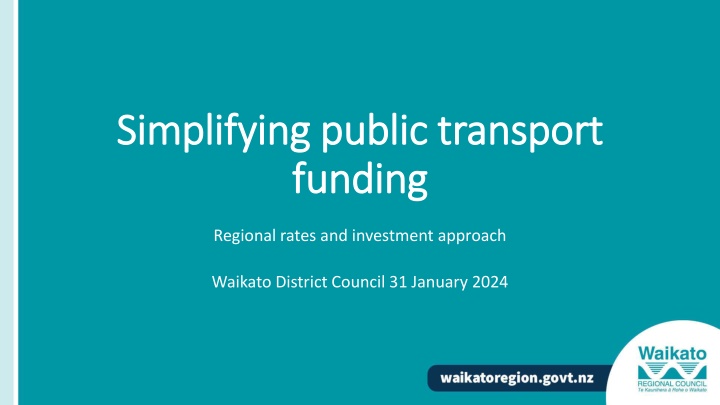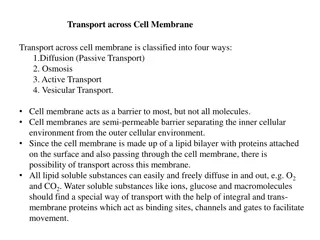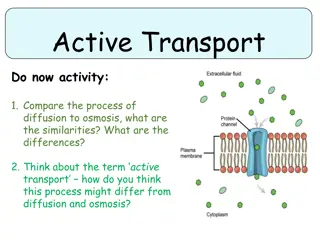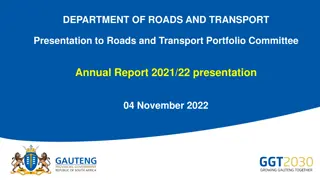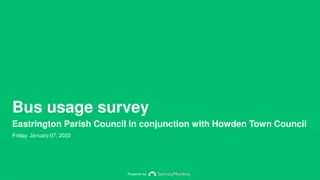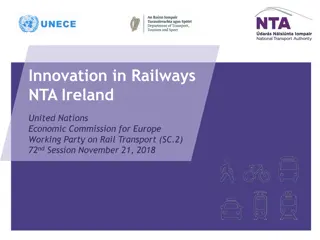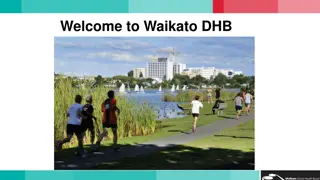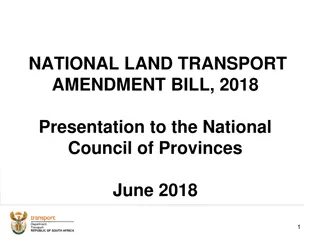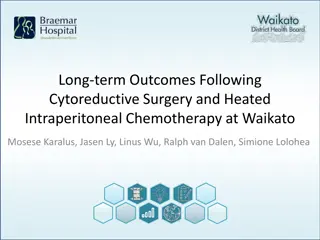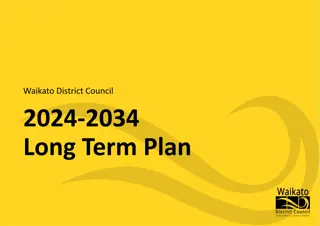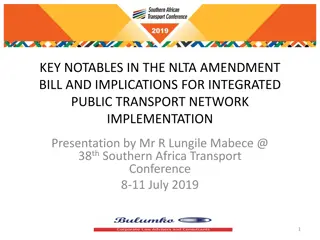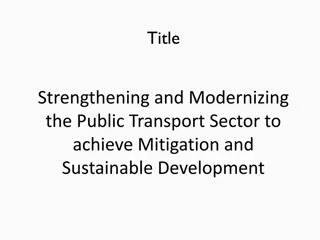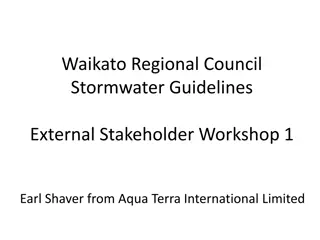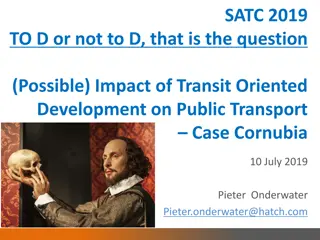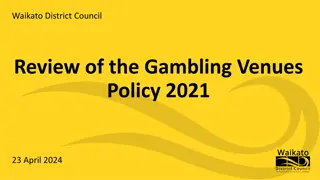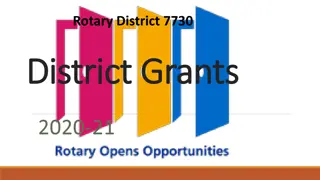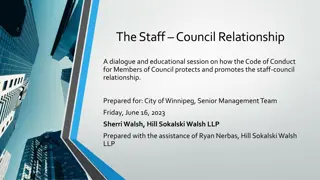Streamlining Public Transport Funding in Waikato District Council
Simplifying and streamlining the public transport funding approach in Waikato District Council to enhance integration, flexibility, and decision-making, while reducing financial risks. The objective is to make it easier to implement the Regional Public Transport Plan and improve the overall transport program.
Download Presentation

Please find below an Image/Link to download the presentation.
The content on the website is provided AS IS for your information and personal use only. It may not be sold, licensed, or shared on other websites without obtaining consent from the author.If you encounter any issues during the download, it is possible that the publisher has removed the file from their server.
You are allowed to download the files provided on this website for personal or commercial use, subject to the condition that they are used lawfully. All files are the property of their respective owners.
The content on the website is provided AS IS for your information and personal use only. It may not be sold, licensed, or shared on other websites without obtaining consent from the author.
E N D
Presentation Transcript
Simplifying public transport Simplifying public transport funding funding Regional rates and investment approach Waikato District Council 31 January 2024
Contents Contents Scope Why? Rating options? Protecting local voices in public transport.
Objective Objective To simplify and streamline the Waikato Region s approach to public transport investment: Making it easier to implement the Regional Public Transport Plan and Metro Spatial Plan Transport Programme Improving integration of services. Increasing flexibility. Speeding up decision-making. Reducing financial and contractual risks to councils.
Typical NZ approach Current Waikato approach
Areas currently rated Areas currently rated and funded by WRC and funded by WRC Hamilton City Hauraki District Matamata-Piako District Thames Coromandel District
Were looking at the local share of net We re looking at the local share of net cost cost Total cost of service (gross cost) User vs public pays NLTF vs Local funding User/fares (20%) 100% Rates (49%) Public (80%) NLTF (51%)
Why? Why? Take you through some examples
Case Study Case Study Te K iti Connector 1 daily return service 8 x funding partners
Waikato Regional Public Transport Plan indicative future network Relying on this type of arrangement will make it harder to achieve and sustain a regional network
LOCAL VOICE INCORPORATED INTO RPTP
Current Public Transport Use Current Public Transport Use Eg in Tamahere parents drop off children on the edge of the city to catch services in to school The Hospital is now being recommended to use the Rotokauri hub and Glenview Hub as informal Park and Ride High volumes of sub division and growth on the edges of HCC mean that lots more people rely on efficient networks in the city to access, shopping, healthcare, employment and social opportunities. The reduction in traffic as a result of bus users is likley to have significant benefits to every person that travels into Hamilton or surrounds even drivers. We also want to change the model to better reflect the benefits of PT, including those related to some existing behaviour
And future investment And future investment This looks at significant improvements including 10 minute frequency services that will connect Ngaruwahia/Horotiu, areas around the airport to each other on fast services that bypass traffic. This will mean that somebody living in Horotiu can get to the CBD in 15 minutes by bus or to future jobs at the Airport in 25-30 mins. Equally those living in peri urban locations will be able to drive to the edges of the main towns park up and jump on a bus or drop of dependents etc
In summary, new regional funding has the In summary, new regional funding has the potential to: potential to: Improve efficiency. Support flexibility, innovation and responsiveness. Better enable inter-district and inter-regional services. Reduce financial and contractual risk to TAs and WRC. Improve resilience. Enable investment in strategic public transport infrastructure. Improve equity of funding obligations.
How? How? How did we develop the options for rating?
Fairness: Costs can be allocated between direct and indirect beneficiaries. Desirable Desirable characteristics characteristics Ease of administration: Minimise administrative burden. Enabling integrated planning and operation: Avoids barriers and creates opportunities for integrated planning and delivery of the network. Factors that informed the options. Some options are better at doing some things than others. Flexibility: Enables the reallocation of funds between services during an LTP. Infrastructure enabled: Could accommodate funding infrastructure in the future.
Benefits range from very local, immediate and Benefits range from very local, immediate and individual to global, public and inter individual to global, public and inter- -generational generational
Assumptions across all options Assumptions across all options All numbers are per annum, indicative & conservatively high there is around $3m net of LCLR funding in Year 2 (this would be close to a third on top of our continuous programme) Direct access is walking distance ~800m Indirect access is bike/scoot/drive to connect ~5km The Metro area is the area covered by the Metro Spatial Plan Transport Programme Business Case. PT IS ALREADY RATED IN SOME WAY BY THE DISTRICT SO UNDER THE CURRENT MODEL WAIKATO DISTRICT WILL BE RATING IN LINE WITH THE COSTS SET OUT IN OUR MODEL. This is a more transparent approach as the rating for PT will be identified in the Regional Council bill.
Option 1 Option 1 Step 1: Cost Allocation Step 1: Cost Allocation Cost allocation undertaken by routes Allocating those costs to the areas served Costs are allocated by district and level of service
Option 1 Option 1 Step 2: Benefit Allocation Step 2: Benefit Allocation Need to identify who benefits and therefore who pays Separation between properties with access to services based on distance (800m) = direct benefit 80% of costs Properties outside 5km = indirect benefit 20% of costs
Option 2 Option 2 Step 1: Cost Allocation Step 1: Cost Allocation Metro costs are separated from other areas Cost is spread among all properties within the metro area
Option 2 Option 2 Step 2: Benefit Allocation Step 2: Benefit Allocation Within metro area no differentiation between properties within 5km Acknowledges network benefits to all users including drivers Outside metro area, 80% direct recovery properties within 5km, 20% indirect across district.
irect access ndirect access Option 1 Option 1 80 % targeted to areas with direct access 20 % targeted to areas with indirect access
Option 2 Option 2 (preferred) (preferred) ndirect access Region ide 80 % targeted to areas with direct + indirect access (yellow areas) ndirect access Region ide 20% regional benefit Hamilton/Waikato metro-area ring-fenced. (all properties in here pay the same)
How does each approach affect the rating How does each approach affect the rating profile? profile? STATUS QUO Commentary EAST WAIKATO (MPDC/HAURAKI/TCDC) Hamilton These numbers are to be confirmed - they are for comparison purposes only - they could fall due to changes in Low Cost Low Risk bid to central government Stats urban defined District-wide $9.11 NZ 800m walk up District-wide $32.00 OPTION 1 - Access $6.21 $0.81 Commentary EAST WAIKATO (MPDC/HAURAKI/TCDC) HAMILTON The move to an access focussed approach concentrates more cost to those within walking distance even in Hamilton. The 5km buffer makes a small difference. 800m walk up 5km Drive up 800m walk up 5km Drive up $31.81 OPTION 2 $6.02 $16.16 $1.59 Commentary EAST WAIKATO (MPDC/HAURAKI/TCDC) METRO (HAMILTON/PARTS OF WAIPA AND WAIKATO) The metro area approach would mean that Hamilton ratepayers would have a reduced rate. This is as a result of more properties paying the metro rate with parts of Waipa and Waikato District paying a greater share for all the buses in metro area. Within 5km District-wide Within 5km District-wide $26.74 $4.87 $6.68 $0.34
Raglan example Raglan example For a property in Raglan within 800m of a Bus Stop, CV $2m CV/$100k STATUS QUO Walk up 800m UNKNOWN RATED LOCALLY Under Option 1, the cost of Waikato services is spread over the TLA, this means that Raglan properties would pay the same as those in Huntly and Pokeno. Under the metro approach, services going to into Hamilton from the metro area (including Huntly, Te Kowhai, Tamahere etc are paid for through property in the Metro area. This leaves Raglan paying for more rural services along with Pokeno OPTION 1 800m walk up $42.35 OPTION 2 Within 5km $3.46 For a property worth $2m STATUS QUO Walk up 800m UNKNOWN RATED LOCALLY OPTION 1 800m walk up $847.02 OPTION 2 Within 5km $69.10
Summary assessment of options against Summary assessment of options against desired characteristics of a funding policy? desired characteristics of a funding policy? Fairness Ease of administration Enabling integration Flexibility Infrastructure enabled Option 1 Medium High Medium Medium Medium Option 2 High Medium High High High
The local voice The local voice How public transport investment will be decided
Regional Councils and Unitary Authorities: Eligible for investment from the National Land Transport Fund. Responsible for preparing the Regional Public Transport Plan. Responsible for procuring public transport services. Can own public transport assets. Can run public transport services. The legal basis The legal basis Land Transport Management Act 2002 To be eligible for NLTF investment services must be identified in a Regional Public Transport Plan. Having a role in deciding what is in the RPTP is critical.
Who decides what Who decides what goes in the plan? goes in the plan? WRC has delegated to: Regional PT Plan Waikato Regional Council Regional Transport Committee - overall responsibility for the RPTP. - preparing, reviewing and consulting on the RPTP - recommending significant changes to the RPTP to WRC. Regional Transport Committee Future Proof PT Subcommittee - making non-significant change to the PT Plan. - Advising the RTC on RPTP as it relates to the Future Proof sub-region. Future Proof Public Transport Subcommittee Non-significant changes Plan reviews and significant changes
Whats next? What s next?
Some uncertainty in the short term Some uncertainty in the short term Government is updating Government Policy Statement on Land Transport (to be released some time early 2024) until then some uncertainty over: NLTF PT Investment levels. Criteria for NLTF investment. This will lead to uncertainty over a large proportion of the net budget going into the LTP
Long Term Plan Consultations Long Term Plan Consultations WRC currently confirming consultation questions for LTP 2024-34: Whether to rate for and fund PT Regionally. Preferred option TAs to signal through Long Term Plan consultation (except HCC, HDC, MPDC, TCDC: WRC is considering taking on rating and funding PT regionally Therefore TA funding of PT may no longer be required. Implementation from year 2 (2025) allowing for more certainty of investment required and some detail to be fleshed out.
Thank you Thank you Sarah Loynes, Manager Transport Policy and Programmes sarah.loynes@waikatoregion.govt.nz Nigel King, Team Leader Transport Policy and Programmes nigel.king@waikatoregion.govt.nz
